Your Call
Which do you think are the three strongest of today’s featured images? Why did you make your choices?
If …
If you are subscribed and had previously been receiving blog post notifications via e-mail on a regular basis and they quit coming in the last month or so, please let me know via e-mail and cut and paste this into the subject line: Please Add to the Personalized Blog Notification List. It seems that some e-mail providers (likely including Gmail) recently began blocking the blog post notification e-mails being sent by the Word Press Newsletter plugin. The new, authenticated sending address was supposed to fix that problem, but it has not 🙂 Life goes on.
Don’t Just Shoot: Learn
If you are interested in changing your life and becoming a better photographer by joining me on the Extended IPT at Sebastian Inlet for Ospreys and more (OCT 25 to NOV 24, 2025), in San Diego for Pacific-race Brown Pelicans and more (JAN 6 to FEB 2, 2026) as below, or for Roseate Spoonbills at Stick Marsh (March 2026 — details coming soon), please e-mail for dates, rates, terms, and additional information. Or shoot me a text to 863-221-2372. Most offerings include options for shared AirBnB lodging and meals. Ground transportation during your stay is a possibility at times.
What’s Up?
On Thursday and Friday past, the temperature had dropped considerably and the northwest wind blew in excess of 20mph. Each morning found three or four dozen Ospreys fishing (and catching) at Sebastian Inlet. But with mostly clear skies, traditional front-lit photography was pretty much impossible as is almost always the case with wind against sun conditions. What to do? Get creative or go home. Thanks to Anke Frohlich, visiting from NYC, for encouraging me to try to photograph the Ospreys backlit in flight, something that on the surface seemed either exceedingly difficult or totally impossible. The result of trying something new were several totally new and different images.
The lessons below are important to all bird photographers. Pros who photograph almost every day can expand their horizons while folks working a full time job can learn some new things to try when the wind is blowing right at the sun. It goes without saying that very few folks on Thursday and Friday past were looking to the southeast. Most were working with the sun behind them and the wind in their face shooting only Osprey butts.
The wind has been NW for several days and a light NW breeze is in the forecast for this morning, Monday 3 November 2025. We will be headed out very early to try for some more silhouettes and other types of backlit images. Whatever you opt to do, I hope that you choose to have fun and get some good things accomplished.
If an item — a Delkin flash card or reader, a Levered-clamp FlexShooter Pro, or a Wimberley lens plate or low foot — for example, that is available from B&H and/or Bedfords, is also available in the BAA Online Store, it would be great, and greatly appreciated, if you would opt to purchase from us. We will match or beat any price. Please remember also to use my B&H affiliate links or to earn 3% cash back at Bedford by using the BIRDSASART discount code at checkout for your major gear purchases. Doing either often earns you free guides and/or discounts. And always earns my great appreciation.
Gear Questions and Advice
Too many folks attending BAA IPTs and dozens of photographers whom I see in the field and on BirdPhotographer’s.Net, are — out of ignorance — using the wrong gear, especially when it comes to tripods and more especially, tripod heads. And the same is true in spades when ordering new camera bodies or lenses. My advice will often save you some serious money and may help you avoid making a seriously bad choice. Please know that I am always glad to answer your gear questions via e-mail. If you are desperate, you can try me on my cell at 863-221-2372. Please leave a message and shoot me a text if I do not pick up.
B&H Simplified
To ensure that I get credit for your B&H purchases, you can always click here. The tracking is invisible but using my affiliate links is greatly appreciated. And, with B&H, you can use your PayBoo card. You must use the website to order. You cannot get your free guides if you make a phone order. Once you have an item in your cart, you must complete the order within two hours. Huge thanks!
B&H
Many folks have written recently stating that they purchased a Sony a1 from B&H and would like their free membership in the Sony 1 Info and Updates Group, a $150.00 value. But when I check my affiliate account, their orders have not been there. When I let them know that they get credit for B&H purchases only if they use one of the many B&H affiliate links on the blog or begin their searches with this link, they are always disappointed. If in doubt, please contact me via e-mail and request a BH link. I am always glad to help and to guide you to the right gear.
Bedfords Simplified
Click here to start your search. Choose standard shipping, and when you get to the payment page, enter BIRDSASART in the discount code box and hit apply. You will be upgraded to free second day air Fed-Ex and receive 3% cash back on your credit card once your stuff ships. Using either my affiliate links is greatly appreciated and will often earn you free guides or discounts. To receive a free guide or free entry into a Sony Set-up and Info Notes e-Mail group, you need to shoot me your receipt via e-mail. The B&H receipts need to include the order number.
Bedfords Amazing BAA Discount Policy
Folks who have fallen in love with Bedfords can always use the BIRDSASART coupon code at checkout to enjoy a post-purchase, 3% off-statement credit (excluding taxes and shipping charges) on orders paid with a credit card. The 3% credit will be refunded to the card you used for your purchase when your product ships. Be sure, also, to check the box for free shipping to enjoy free Second Day Air Fed-Ex. This offer does not apply to purchases of Classes, Gift Cards, or prior purchases.
You can visit the Bedfords website here, shoot Steve Elkins an e-mail, or text him on his cell phone at (479) 381-2592.
|
|
|
This image was created on 24 October 2025 by yours truly. Standing at full height on the way back to my SUV to change lenses, I used the handheld Sony FE 70-200mm f/2.8 GM OSS II lens with the with theSony FE 1.4x Teleconverter (at 280mm) and The Latest Greatest Sony Flagship Body, the a1 II Mirrorless Camera. The exposure was determined by Zebras with Exposure Compensation (EC) on the thumb wheel. Multi Metering +0.7 stops. AUTO ISO set ISO 640: 1/15 second at f/4 (wide open) in Shutter Priority mode. AWB at 7:19:43am in the shade of some tall beach vegetation. Wide/AF-C with Bird-Eye/Face Detection performed perfectly. Click on the image to enjoy the larger high-res version. Image #1: Brown Pelicans fishing blur |
When You Don’t Know What to Expect
Dealing With Wind Against Sun Conditions, Look for Birds in the Shade
When you have no idea what to expect, Shutter Priority Mode with Auto ISO and Exposure Compensation on a convenient dial is a great place to be. I was headed back to my car to grab a longer lens when I encountered a very brief pelican feeding spree. How brief? Perhaps 30 seconds at most. With the relatively dark water and some white feathers on the pelicans, my knowledge of exposure theory led me to dial in +2/3 stop of EC and that was confirmed by Sony’s Zebra technology.
For folks who have a thorough understanding of Exposure Theory (as detailed in the original soft cover The Art of Bird Photography), Shutter Priority as detailed above is a fast efficient way to deal with unforeseeable situations. That said, folks with a thorough understanding of Exposure Theory are far better equipped to come up with the right exposure when working in Manual or any other mode as well.
|
|
|
This image was created on 28 October 2025 on a Sebastian Inlet Extended IPT. Standing at full height I used the Robus RCM-439 4-Section Carbon Fiber Monopod, /Wimberley MonoGimbal Head-supported Sony FE 400-800mm f/6.3-8 G OSS lens (Sony E) (at 800mm) and The Latest Greatest Sony Flagship Body, the a1 II Mirrorless Camera. The exposure was determined by Zebras with Exposure Compensation (EC) on the thumb wheel. Multi Metering +2.0 stops. AUTO ISO set ISO 3200: 1/8 second at f/8 (wide open) in Shutter Priority mode. RawDigger showed that the exposure was dead-solid perfect. AWB at 7:13:10am moments before sunrise. Lower center Tracking: Zone/AF-C with Bird-Eye/Face Detection performed perfectly. Click on the image to enjoy the larger, inexplicably sharper high-res version. Image #2: Wave pan blur |
Creating Effective Pan Blurs
Dealing With Wind Against Sun Conditions, Arrive Well Before Sunrise
Every morning before the sun rises, the ocean and the beach south of the South Jetty at Sebastian Inlet State Park provide pretty much endless opportunities for creating pleasing pan blurs. I like panning smoothly from left to right with shutter speeds of
1/8 or 1/6 second and striving to include a stretch of beach in the frame.
|
|
|
This image was created on 28 October 2025 on a Sebastian Inlet Extended IPT. Standing at full height I used the Robus RCM-439 4-Section Carbon Fiber Monopod, 65/Wimberley MonoGimbal Head-supported Sony FE 400-800mm f/6.3-8 G OSS lens (Sony E) (at 800mm) and The Latest Greatest Sony Flagship Body, the a1 II Mirrorless Camera. The exposure was determined by Zebras with Exposure Compensation (EC) on the thumb wheel. Multi Metering +1.3 stops. AUTO ISO set ISO 400: 1/8 second at f/8 (wide open) in Shutter Priority mode. RawDigger showed that the exposure was dead-solid perfect. AWB at 7:16:03am right at sunrise. Lower center Tracking: Zone/AF-C with Bird-Eye/Face Detection performed perfectly. Click on the image to enjoy the larger, inexplicably sharper high-res version. Image #3: Wet sand sunrise reflections pan blur |
Dealing With Wind Against Sun Conditions: Add Sunrise Colors to Your Pan Blurs
Even on days with relatively clear skies and NW winds there are almost always some light clouds on the eastern horizon. As the sun rises, the clouds will provide some nicely colored reflections. To maximize the color, I placed the sun directly behind a swatch of wet sand as the subject for Image #3.
|
|
|
This image was created on 28 October 2025 on a Sebastian Inlet Extended IPT. Standing at full height I used the Robus RCM-439 4-Section Carbon Fiber Monopod, 65/Wimberley MonoGimbal Head-supported Sony FE 400-800mm f/6.3-8 G OSS lens (Sony E) (at 705mm) and The Latest Greatest Sony Flagship Body, the a1 II Mirrorless Camera. The exposure was determined by Zebras with Exposure Compensation (EC) on the thumb wheel. Multi Metering +2 stops. AUTO ISO set ISO 1000: 1/250 second at f/8 (wide open) in Shutter Priority mode. RawDigger showed that the exposure was dead-solid perfect. AWB at 7:33:40am with some light clouds on the eastern horizon. Upper center Tracking: Zone/AF-C with Bird-Eye/Face Detection performed perfectly. Click on the image to enjoy the larger, inexplicably sharper high-res version. Image #4: Great Egret sunrise silhouette |
Dealing With Wind Against Sun Conditions: Think Silhouettes
With the wind blowing toward the sun, the backlit birds will be facing you to some degree as you look at the color. For best results, it is usually best to keep the brightest reflections of the sun in the water out of the frame.
|
|
|
This image was created on 30 October 2025 on a Sebastian Inlet Extended IPT. I used the hand held Sony FE 300mm f/2.8 GM OSS Lens (Sony E) with the Sony FE 1.4x Teleconverter and the Sony a-1 (now replaced by the Latest Greatest Sony Flagship Body, the a1 II Mirrorless Camera). The exposure was determined by Zebras with Exposure Compensation (EC) on the thumb wheel. Multi Metering -0.3 stops. AUTO ISO set ISO 100: 1/2000 second at f/5.6 (wide open) in Shutter Priority mode. RawDigger showed that the exposure was dead solid perfect plus a bit. AWB at 8:20:04am on a variably cloudy morning. Tracking: Zone/AF-C with Bird Eye/Face Detection enabled performed perfectly. Click on the image to enjoy the larger, inexplicably sharper high-res version. Image #5: Snowy Egret backlit in wash |
Dealing With Wind Against Sun Conditions: With a Partially Muted Sun, Think Strong Backlight
On dead clear mornings or once the sun clears the eastern clouds, the reflection of the sun on the water are usually much too bright to deal with. When the sun is fairly bright but is partially muted light clouds, you have a chance to create some strongly backlit images. Again, a a thorough understanding of Exposure Theory (as detailed in the original soft cover The Art of Bird Photography) is mandatory in all exposure situations, especially the difficult ones.
Note that the correct EC for Image #4 was +2 stops while the EC for Image #5 was -1/3 stop. The difference was due to the intensity of the backlight. For #5, -2/3 would have done a bit more to tame the specular highlights.
|
|
|
This image was created on 31 October 2025 on a Sebastian Inlet Extended IPT. I used the handheld Sony FE 300mm f/2.8 GM OSS Lens (Sony E) and the Latest Greatest Sony Flagship Body, the a1 II Mirrorless Camera). The exposure was determined by Zebras with Exposure Compensation (EC) on the thumb wheel. Multi Metering +1.7 stops. AUTO ISO set ISO 1250: 1/1250 second at f/2.8 (wide open) in Shutter Priority mode. RawDigger showed that the exposure was perfect. AWB at 8:20:04am on a variably cloudy morning. Tracking: Zone/AF-C with Bird Eye/Face Detection enabled performed perfectly. Click on the image to enjoy the larger, inexplicably sharper high-res version. Image #6: Osprey diving |
Dealing With Wind Against Sun Conditions: Look for Backlit Flight on Muted Sunrises
With a strong northwest wind, trying to make a good image of a diving Osprey with the light behind you is a futile exercise; the birds will be diving away from you. If you are blessed by some clouds to the east, you may have some good changes on gently backlit bird diving toward you. For Image #6, I was lucky to have the bird dive through a small patch of colored sky well after the official time of sunrise.
|
|
|
This image was created on 31 October 2025 on a Sebastian Inlet Extended IPT. Standing at full height, I used the handheld Sony FE 300mm f/2.8 GM OSS Lens (Sony E) with the Sony FE 2x Teleconverter and the Latest Greatest Sony Flagship Body, the a1 II Mirrorless Camera). The exposure was determined using Zebra technology with ISO on the thumb wheel. ISO 800: 1/8000 sec. at f/6.3 (stopped down 1/3-stop in error). RawDigger showed that the exposure was dead solid perfect: AWB at 9:00:44am on a then sunny morning. Wide/AF-C with Bird Eye/Face Detection enabled performed perfectly. Image #7: Snowy Egret dorsal view flight |
Dealing With Wind Against Sun Conditions: Look for Birds Flying the Wrong Way
While headed back to my SUV I was set up for Ospreys in flight at ISO 800, 1/4000 sec. at f/5.6 hoping to come across a diving bird or one flying the wrong way, toward me and away from the NW wind. Knowing that Snowy Egrets are a lot white than Ospreys, I went two click higher with my shutter speed when I saw this Snowy Egret jump off a jetty rock and inexplicably fly toward me right down sun angle. Bingo!
|
|
|
This image was created by yours truly on 31 October 2025 at Sebastian Inlet State Park on a BIRDS AS ART Extended Instructional Photo-Tour (IPT). Standing at full height, I used the handheld Sony FE 200-600mm f/5.6-6.3 G OSS lens (at 600mm) and the Sony a-1 (now replaced by the Latest Greatest Flagship Body, the Sony a1 II Mirrorless Camera. The exposure was determined via Zebras with ISO on the Thumb Wheel. ISO 1000: 1/5000 sec. at f/6.3 (wide open) in Manual mode. RawDigger showed that the exposure was dead solid perfect plus a bit. AWB at 9:15:43am on a mostly sunny morning. Tracking: Zone/AF-C with Bird-Eye/Face Detection performed perfectly. Click on the image to enjoy a larger, inexplicably sharper high-res version. Image #8: Osprey with tail raised before dive in silhouette |
Dealing With Wind Against Sun Conditions: Keep Trying Various Backlit Flight Situations
On sunny days, handholding the 200-600 for flight allows for getting on a flying bird quickly, for zooming out when needed, yet providing 600mm of reach. I have never seen anything like this flight pose before. Some of the feathers of the bird’s left wing were lit by the sun. I used both the Clone Stamp Tool and the Remove Tool to create a full and complete silhouette.
I love creating completely new and different images.
|
|
|
This image was created by yours truly on 31 October 2025 at Sebastian Inlet State Park on a BIRDS AS ART Extended Instructional Photo-Tour (IPT). Standing at full height, I used the handheld Sony FE 200-600mm f/5.6-6.3 G OSS lens (at 600mm) and the Sony a-1 (now replaced by the Latest Greatest Flagship Body, the Sony a1 II Mirrorless Camera. The exposure was determined via Zebras with ISO on the Thumb Wheel. ISO 800: 1/4000 sec. at f/6.3 (wide open) in Manual mode. RawDigger showed that the exposure was dead solid perfect. AWB at 9:20:40 am on a then sunny morning. Tracking: Zone/AF-C with Bird-Eye/Face Detection performed perfectly. Click on the image to enjoy a larger, inexplicably sharper high-res version. Image #9: Atlantic Needlefish in Osprey’s talons |
Dealing With Wind Against Sun Conditions: Try Something Fishy
I’ve been having lots of fun creating these fishy images. Seeing a fairly large needlefish in the osprey’s talons I fired off a long series of images so that I had a choice of fish positions. This one is of course another large crop. The incredibly detailed 51 megapixel raw files from a Sony a-1 or an a-1 ii allow for large even huge crops as long as the files are sharp and exposed to the right.
|
|
|
This image was created by yours truly on 31 October 2025 at Sebastian Inlet State Park on a BIRDS AS ART Extended Instructional Photo-Tour (IPT). Standing at full height, I used the handheld Sony FE 200-600mm f/5.6-6.3 G OSS lens (at 481mm) and the Latest Greatest Flagship Body, the Sony a1 II Mirrorless Camera. The exposure was determined via Zebras with ISO on the Thumb Wheel. ISO 800: 1/4000 sec. at f/6.3 (wide open) in Manual mode. RawDigger showed that the exposure was dead solid perfect plus a bit. AWB at 9:23:49am on a mostly sunny morning. Tracking: Zone/AF-C with Bird-Eye/Face Detection performed perfectly. Click on the image to enjoy a larger, inexplicably sharper high-res version. Image #10: Osprey backlit in flight |
Dealing With Wind Against Sun Conditions: Try Something That You Had Previously Thought Impossible
The northwest wind on Friday was so strong that creating a front-lit image of an Osprey in flight seemed pretty much impossible. There were 5o or so Ospreys fishing both in and out of the Inlet.
So, I turned around faced the sun, and looked for a strongly backlit Osprey above me to the southeast while of course facing northwest. The raw file looked disgusting washed out bordering on over-exposed. I used something like seven different masks in Adobe Camera Raw to bring the image to life. The image optimization will be detailed in Volume III of the Digital Basics IV Video Series. . Check out the original immediately below.
|
|
|
This Photo Mechanic screen capture depicts the raw file for Image #9. Image #10A: Osprey backlit in flight — the original capture |
Don’t Be Icarus
The strongest backlight — as in Image #10 — will be in the sky in close proximity to the sun. But it would be fatal to include the sun in the frame. Not to mention that creating an image with the bird centered in the unmuted sun would be virtually impossible and potentially damaging to the retina, the light-sensitive tissue at the back of the eye (solar retinopathy). In addition, the intense light might burn the cornea, the clear outer layer of the eye, in a painful condition called photokeratitis. Both can lead to temporary or permanent vision problems like distorted vision, blind spots, or blurred vision. Resist the urge to try it.
|
|
|
This image was created on 31 October 2025 by yours truly at Sebastian Inlet State Park on a BIRDS AS ART Extended Instructional Photo-Tour (IPT). Standing at full height, I used the handheld Sony FE 200-600mm f/5.6-6.3 G OSS lens (at 600mm) and the Latest Greatest Flagship Body, the Sony a1 II Mirrorless Camera. The exposure was determined via Zebras with ISO on the Thumb Wheel. ISO 800: 1/6400 sec. at f/6.3 (wide open) in Manual mode. RawDigger showed that the exposure was dead solid perfect plus a bit. AWB at 10:04:45am on a then mostly sunny morning. Tracking: Zone/AF-C with Bird-Eye/Face Detection performed perfectly. Click on the image to enjoy a larger, inexplicably sharper high-res version. Image 11: Osprey looking back in flight |
Dealing With Wind Against Sun Conditions: Get Lucky With a Look-back, Peekaboo Head Turn
With a strong northwest wind on a sunny morning, the fishing Ospreys will always face into the wind while hovering above the inlet looking for breakfast. I was hoping for a spread tail butt shot from the rear when this bird decided to peek back over its shoulder. With the bird’s face in the shade I again used a mask during the raw conversion in ACR to lighten it. The ACR masking feature will be detailed extensively in detailed in Volume III of the Digital Basics IV Video Series. .
|
|
|
This image was created on 2 November 2025 on a Sebastian Inlet Extended IPT. Standing at full height I used the Robus RC-5570 Vantage Series 3 Carbon Fiber Tripod/Levered-Clamp FlexShooter Pro-mounted Sony FE 400-800mm f/6.3-8 G OSS lens (Sony E) (at 800mm) and The Latest Greatest Sony Flagship Body, the a1 II Mirrorless Camera. The exposure was determined by Zebras with Exposure Compensation (EC) on the thumb wheel. Multi Metering +1.3 stops. AUTO ISO set ISO 2000: 1/2500 second at f/8 (wide open) in Shutter Priority mode. RawDigger showed that the exposure was dead-solid perfect. AWB at 7:43:52am with some light clouds on the eastern horizon. Lower center Tracking: Zone/AF-C with Bird-Eye/Face Detection performed perfectly. Click on the image to enjoy the larger, inexplicably sharper high-res version. Image #12: Great Blue Heron sunrise silhouette pano |
Dealing With Wind Against Sun Conditions: Don’t Give Up
After moving the clock back an hour early Sunday morning, sunrise came an hour earlier at 6:33am. Though there was not much going on at all silhouette-wise for more than an hour, I stuck with it and was eventually rewarded when two great blues flew through the color.
Typos
With all blog posts, feel free to e-mail or to leave a comment regarding any typos or errors.


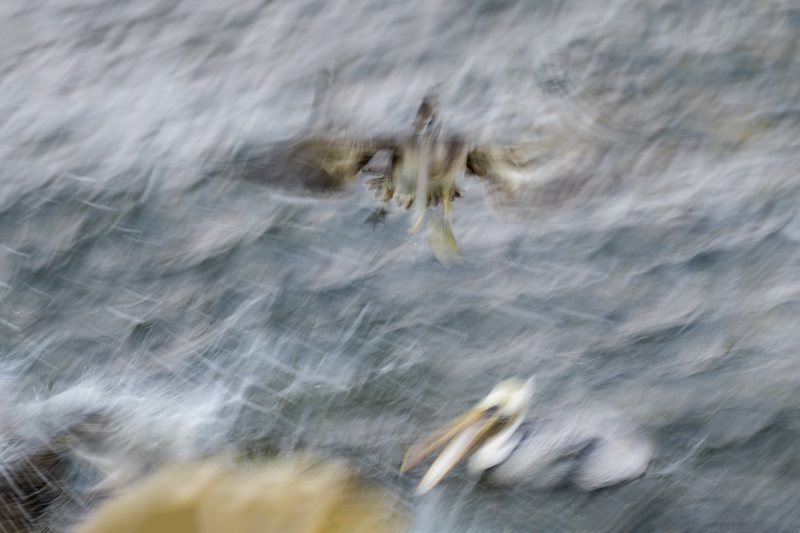
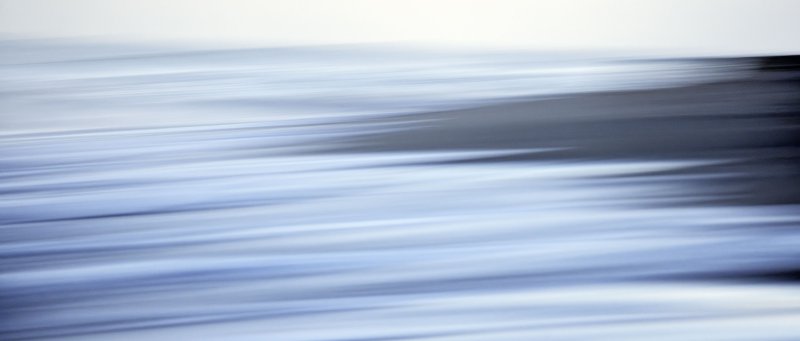
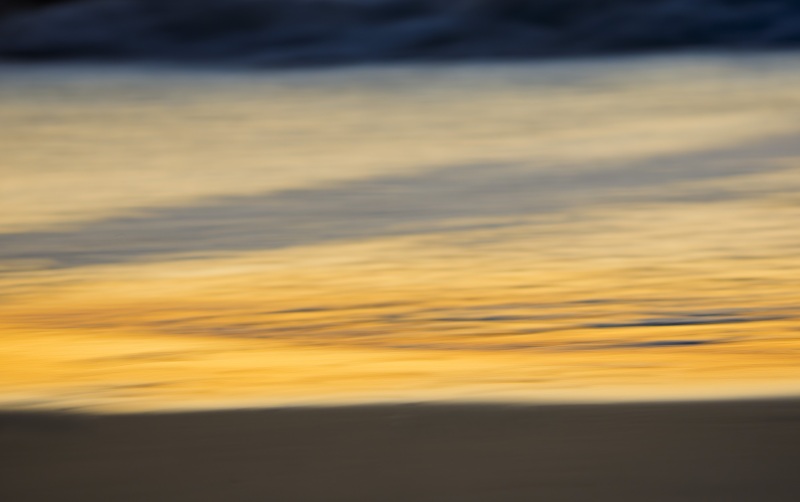


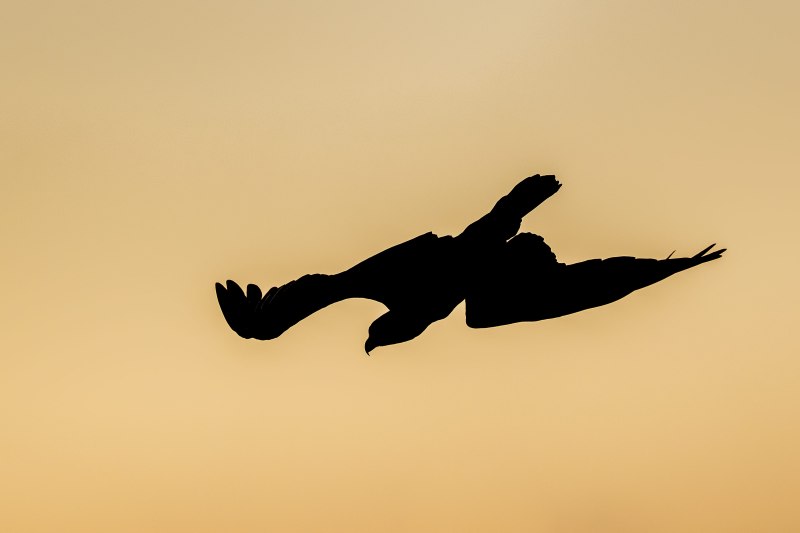
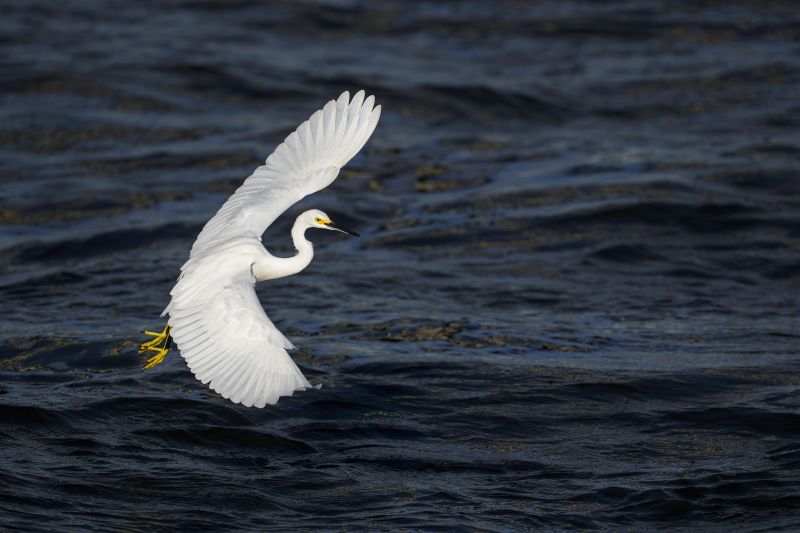
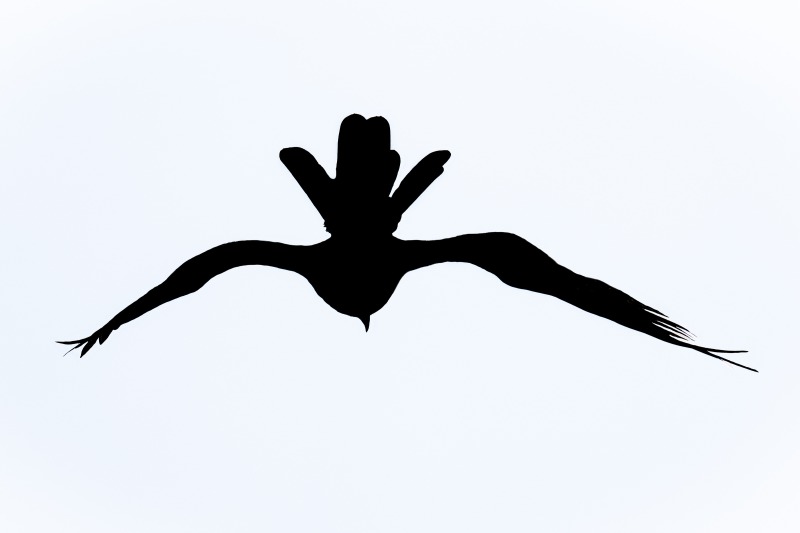
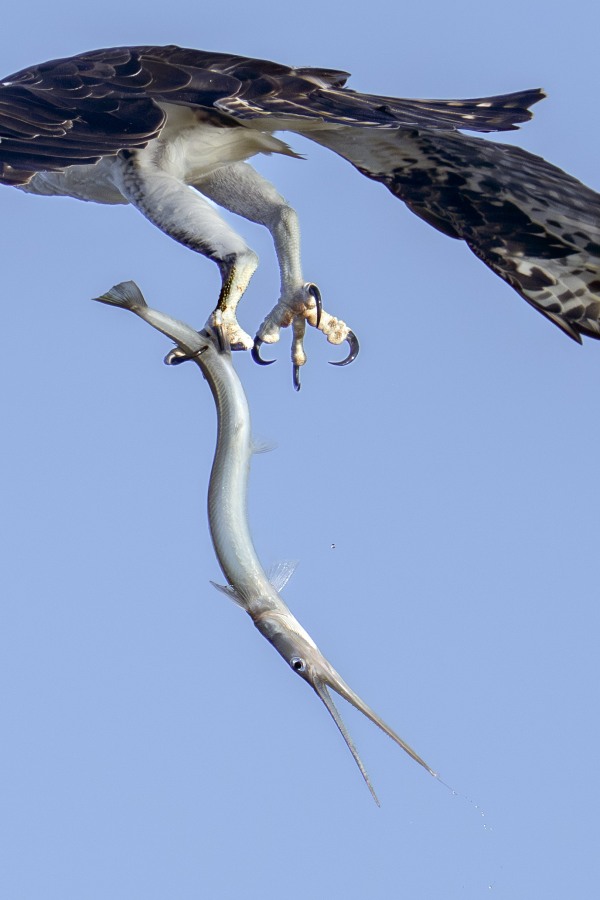

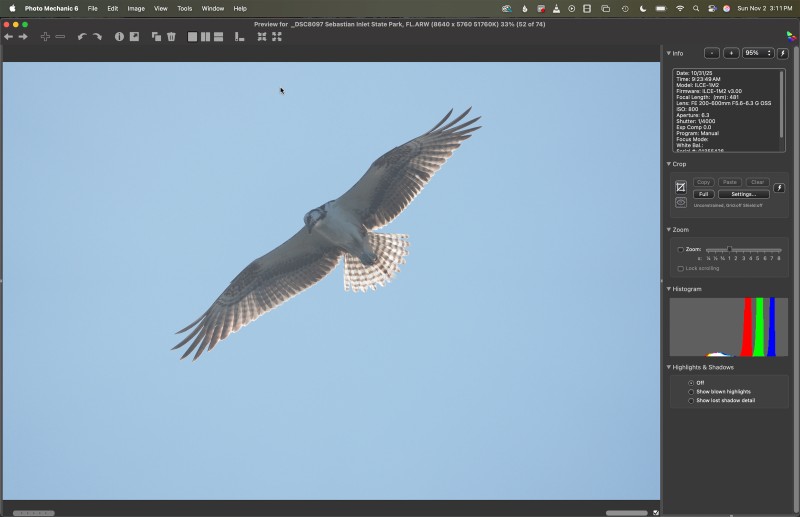








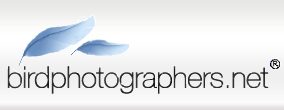


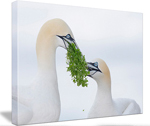



I Like image #1. The blur adds such a dreamy, painterly feel — beautiful sense of movement and freedom. The motion blur really brings the pelican and waves to life.
Images 5, 6, 12 & 8 for me. I always look for the shots that I would frame and display quite happily in my home. Image 5 really fits that bill. I can admire the others (apart from the blurs!), but they don’t appeal as much to me. Image 9 is ‘wow’ inspiring both in content and technique, but wouldn’t adorn any of my walls!
Thanks for commenting. We already know that you hate blurs so no need to mention that :-).
Do you like any Monet stuff?
artie